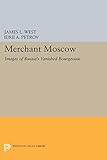Merchant Moscow : Images of Russia's Vanished Bourgeoisie / ed. by Iurii A. Petrov, James L. West.
Material type: TextSeries: Princeton Legacy Library ; 372Publisher: Princeton, NJ : Princeton University Press, [2014]Copyright date: ©1998Edition: Course BookDescription: 1 online resource (346 p.) : 231 halftones 2 mapsContent type:
TextSeries: Princeton Legacy Library ; 372Publisher: Princeton, NJ : Princeton University Press, [2014]Copyright date: ©1998Edition: Course BookDescription: 1 online resource (346 p.) : 231 halftones 2 mapsContent type: - 9780691603780
- 9781400864645
- 305.5/54/094731 23
- online - DeGruyter
- Issued also in print.
| Item type | Current library | Call number | URL | Status | Notes | Barcode | |
|---|---|---|---|---|---|---|---|
 eBook
eBook
|
Biblioteca "Angelicum" Pont. Univ. S.Tommaso d'Aquino Nuvola online | online - DeGruyter (Browse shelf(Opens below)) | Online access | Not for loan (Accesso limitato) | Accesso per gli utenti autorizzati / Access for authorized users | (dgr)9781400864645 |
Frontmatter -- Contents -- INTRODUCTION -- Merchant Moscow in Historical Context -- A Note on Old Belief -- A Note on Photography in Russia -- About the Photographs -- PART ONE. FROM STREET FAIR TO DEPARTMENT STORE BUSINESS CULTURE AND PRACTICES -- CHAPTER 1. Doing Business in Merchant Moscow -- CHAPTER 2. Moscow's Commercial Mosaic -- CHAPTER 3 "Moscow City": Financial Citadel of Merchant Moscow -- PART TWO. ICON AND BUSINESS CARD. MERCHANT CULTURE, RITUAL, AND DAILY LIFE -- CHAPTER 4. Caftan to Business Suit: The Semiotics of Russian Merchant Dress -- CHAPTER 5. Old Believers and New Entrepreneurs: Religious Belief and Ritual in Merchant Moscow -- CHAPTER 6. Daily Life among the Morozovs -- PART THREE. BEYOND THE BOARDROOM SOCIAL HIERARCHIESGENDER, CLASS, AND EDUCATION -- CHAPTER 7. Peasant Entrepreneurs and Worker Peasants: Labor Relations in Merchant Moscow -- CHAPTER 8. Daughters, Wives, and Partners: Women of the Moscow Merchant Elite -- CHAPTER 9. Commercial Education and the Cultural Crisis of the Moscow Merchant Elite -- PART FOUR. A CITY OF ONE'S OWN. RESHAPING CULTURE AND SPACE -- CHAPTER 10. Aesthetics and Commerce: The Architecture of Merchant Moscow, 1890-1917 -- CHAPTER 11. Merchant Moscow After Hours: Voluntary Associations and Leisure -- PART FIVE. MERCHANT DREAMS SELF-IMAGE AND UTOPIAN VISION -- CHAPTER 12. Merchants on Stage and in Life: Theatricality and Public Consciousness -- CHAPTER 13. Visions of Russia's Entrepreneurial Future: Pavel Riabushinsky's Utopian Capitalism -- CONCLUSION -- The Fate of Merchant Moscow -- Suggestions for Further Reading -- Contributors -- Index
restricted access online access with authorization star
http://purl.org/coar/access_right/c_16ec
With the collapse of the Soviet system, the long-neglected history of the early capitalists is being recovered and rewritten. Once regarded as the "losers" in the Russian Revolution, these merchants can now be seen as early pioneers in Russia's transformation to a free market economy. This book is the first joint Russian-American collaborative project on the history of Russian entrepreneurship. Merchant Moscow puts a human face on early Russian capitalism. It presents thematic groupings of historic photographs paired with commentaries by contemporary Russian and American historians. The pictures provide a stunning, wide-ranging visual portrait of Imperial Russia's most influential entrepreneurial elite, the Moscow merchantry, while the accompanying articles interpret the photographs and place them in the larger cultural context of prerevolutionary Russia. Here is a surprising new view of the bourgeoisie during the Silver Age, revealed for the first time in this fascinating volume.The fourteen contributing historians selected and ordered photographs that best illustrate their specialized knowledge of the period. They have framed their topics in a variety of ways. Some have chosen to pursue traditional topics, such as collective biography, institutional history, or the history of business practices. Others have approached the photographs in more experimental ways, emphasizing the semiotics of dress, discourses of identity, or the history of daily life. Together they offer fresh perspectives on the successes and failures of Russia's first experiment with entrepreneurial capitalism.Originally published in 1998.The Princeton Legacy Library uses the latest print-on-demand technology to again make available previously out-of-print books from the distinguished backlist of Princeton University Press. These editions preserve the original texts of these important books while presenting them in durable paperback and hardcover editions. The goal of the Princeton Legacy Library is to vastly increase access to the rich scholarly heritage found in the thousands of books published by Princeton University Press since its founding in 1905.
Issued also in print.
Mode of access: Internet via World Wide Web.
In English.
Description based on online resource; title from PDF title page (publisher's Web site, viewed 30. Aug 2021)


